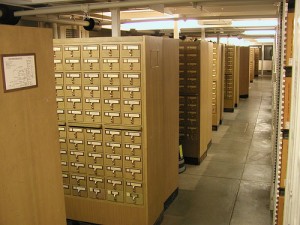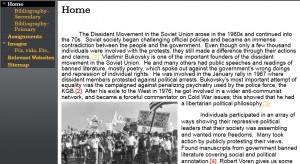Guest blogger John Corcoran received his PhD from Georgetown University in 2012. His dissertation examined the political culture of local self-government in late Imperial Russia. His current research interests include zemstvo liberalism and social welfare programs. Since 2012, he has been a Visiting Assistant Professor in the Department of History at Goucher College in Towson, MD.
Many thanks to Karl for the opportunity to post. Given the interesting questions raised by Gleb Tsipursky’s series of posts and responses from Alyssa DeBlasio and Karl about the sorts of skills we want to impart in our teaching, I thought it would be useful for me to discuss my experience with alternative projects in my Russian history courses at Goucher College.
As a sort of experiment during the spring 2013 semester, I offered students in my History of Medieval Russia class the opportunity to pursue a creative project in lieu of the semester paper. I continued the option in fall 2013 with my courses on Imperial Russia and the Jews of Russia and the Soviet Union.
The project, like the paper, would involve research on a topic of their choosing, but the final product was up to them. I specified that “creative” projects were to meet the following criteria: 1) They must have a research component; 2) They must have a defined final product; and 3) That final product must have educational value for a hypothetical future version of the course. As with the standard research papers, students were required to submit proposals at the beginning of the project and research updates in advance of the final submission.

Surprisingly, only a handful of students elected to do an alternative project, but those projects demonstrated a wide range of interests and types of final products. Topics ranged from Muscovite armor to Russian Jewish cuisine (with samples) to the peoples of Siberia to the art of Marc Chagall. Final products included a shield and mail shirt, a map, digital slide shows, and a video.
As a final summation and a prelude to this blog post, I interviewed students from each class to get their thoughts on the project. Students were generally positive about the opportunity to do an alternative project, but also mentioned some considerations that dissuaded many of them from pursuing it to completion. Based on those interviews and my own observations, I came up with the following list of benefits and drawbacks to consider, both for students contemplating these projects and for us as their teachers:
Benefits
–Engagement: On the whole, students who did creative projects showed more enthusiasm than did their counterparts writing conventional research papers. Even enthusiastic history majors complained of “paper fatigue.” When the end of the semester requires dozens of pages of writing spread across multiple courses, some work on a hands-on project can feel like a welcome respite.
–Project management skills: One of the students interviewed said something along the lines of “You can’t make armor at the last minute.” He was actually grateful that this project forced him to make a schedule, to budget, and to account for unforeseen obstacles—like college students the world over, he has written his share of papers at 3AM the night before they are due. Given the concerns that have been raised recently about college graduates’ employability skills, this would seem to be a particular point to emphasize for students and employers both.
–Utility in future courses: The tangible final products can be of benefit as teaching aids. Slideshows or other digital materials can of course be copied, and students might be persuaded to share their creations. In other words, you better believe I will be wearing that shield next time I teach Medieval Russia.
—Information Management: This, to me, is the aspect that students appreciated the least, so I plan to emphasize it more heavily in future semesters. As our increasing forays into digital humanities are demonstrating, standard prose is not always the best way to convey information, and it requires a different set of skills to think through the best way to present a concept or a cluster of data. These skills are useful in the outside world, but they also reflect on what we are trying to do in academia. By assigning projects like this, we can press students to think differently about the learning process, and perhaps in turn we might ask ourselves some of the same questions about our teaching methods.
Drawbacks:
–Time: A number of students suggested that they had planned to do creative projects, but were daunted by the time constraints. They suggested I begin project discussions earlier in the semester, to allow more time to plan (this past semester, project planning began about halfway through the course). The drawback, though, is that they will be exposed to even less of the course material before making a determination about their project.
–Tools: Students need to be able to acquire the skills–digital or otherwise–that will allow them to complete the project. This gets at the substance of Karl’s last post, and I agree completely that we need to devote more class time to teaching students how to use these technologies. But, the more complex programs might be beyond our ken, and we don’t necessarily want them all to use the same ones. Long-term, we may want to work towards integrating digital skills courses into our curricula; until that happens, I intend to put a lot more effort into connecting students to the resources (on campus or online) that will teach them the skills that I cannot.
On the whole, I think the pluses definitely outweighed the minuses, and I’m looking forward to using this approach in future courses. I’d love to hear any comments about your experiences with non-conventional project types.







